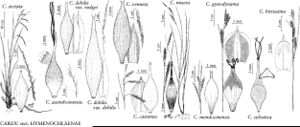Difference between revisions of "Carex debilis var. rudgei"
Mem. Torrey Bot. Club 1: 34. 1889.
FNA>Volume Importer |
imported>Volume Importer |
||
| (6 intermediate revisions by 2 users not shown) | |||
| Line 8: | Line 8: | ||
}} | }} | ||
|common_names=Carex de Rudge | |common_names=Carex de Rudge | ||
| + | |special_status={{Treatment/ID/Special_status | ||
| + | |code=F | ||
| + | |label=Illustrated | ||
| + | }}{{Treatment/ID/Special_status | ||
| + | |code=E | ||
| + | |label=Endemic | ||
| + | }} | ||
|basionyms= | |basionyms= | ||
|synonyms={{Treatment/ID/Synonym | |synonyms={{Treatment/ID/Synonym | ||
|name=Carex allegheniensis | |name=Carex allegheniensis | ||
|authority=Mackenzie | |authority=Mackenzie | ||
| − | }}{{Treatment/ID/Synonym | + | |rank=species |
| + | }} {{Treatment/ID/Synonym | ||
|name=Carex debilis var. intercursa | |name=Carex debilis var. intercursa | ||
|authority=Fernald | |authority=Fernald | ||
| − | }}{{Treatment/ID/Synonym | + | |rank=variety |
| + | }} {{Treatment/ID/Synonym | ||
|name=Carex debilis var. interjecta | |name=Carex debilis var. interjecta | ||
|authority=L. H. Bailey | |authority=L. H. Bailey | ||
| − | }}{{Treatment/ID/Synonym | + | |rank=variety |
| + | }} {{Treatment/ID/Synonym | ||
|name=Carex debilis var. pubera | |name=Carex debilis var. pubera | ||
|authority=A. Gray | |authority=A. Gray | ||
| − | }}{{Treatment/ID/Synonym | + | |rank=variety |
| + | }} {{Treatment/ID/Synonym | ||
|name=Carex debilis var. strictior | |name=Carex debilis var. strictior | ||
|authority=L. H. Bailey | |authority=L. H. Bailey | ||
| − | }}{{Treatment/ID/Synonym | + | |rank=variety |
| + | }} {{Treatment/ID/Synonym | ||
|name=Carex flexuosa | |name=Carex flexuosa | ||
| − | |authority= | + | |authority= |
| − | }}{{Treatment/ID/Synonym | + | |rank=species |
| + | }} {{Treatment/ID/Synonym | ||
|name=Carex tenuis | |name=Carex tenuis | ||
| − | |authority= | + | |authority= |
| + | |rank=species | ||
}} | }} | ||
|hierarchy=Cyperaceae;Carex;Carex sect. Hymenochlaenae;Carex debilis;Carex debilis var. rudgei | |hierarchy=Cyperaceae;Carex;Carex sect. Hymenochlaenae;Carex debilis;Carex debilis var. rudgei | ||
| Line 44: | Line 58: | ||
|habitat=Edges, openings, paths and stream banks in dry to mesic deciduous forest, meadows, wet prairies, roadsides, usually on soils with pH below 6 | |habitat=Edges, openings, paths and stream banks in dry to mesic deciduous forest, meadows, wet prairies, roadsides, usually on soils with pH below 6 | ||
|distribution=N.B.;Nfld. and Labr.;N.S.;Ont.;P.E.I.;Que.;Conn.;Del.;D.C.;Ga.;Ill.;Ind.;Ky.;Maine;Md.;Mass.;Mich.;Minn.;N.H.;N.Y.;N.C.;Pa.;R.I.;Tenn.;Vt.;Va.;W.Va.;Wis. | |distribution=N.B.;Nfld. and Labr.;N.S.;Ont.;P.E.I.;Que.;Conn.;Del.;D.C.;Ga.;Ill.;Ind.;Ky.;Maine;Md.;Mass.;Mich.;Minn.;N.H.;N.Y.;N.C.;Pa.;R.I.;Tenn.;Vt.;Va.;W.Va.;Wis. | ||
| − | |discussion=<p>Most collections of the northern variety, Carex debilis var. rudgei, have glabrous perigynia, but those with pubescent perigynia can be found in the southeastern part of the range, especially in the mountains. The two forms often grow together in the same population. Hybrids with both C. virescens and C. swanii occur sporadically throughout their common range. A rare hybrid with C. castanea occurs in the northern part of its range.</p> | + | |discussion=<p>Most collections of the northern variety, <i>Carex debilis </i>var.<i> rudgei</i>, have glabrous perigynia, but those with pubescent perigynia can be found in the southeastern part of the range, especially in the mountains. The two forms often grow together in the same population. Hybrids with both <i>C. virescens</i> and <i>C. swanii</i> occur sporadically throughout their common range. A rare hybrid with <i>C. castanea</i> occurs in the northern part of its range.</p> |
|tables= | |tables= | ||
|references= | |references= | ||
| Line 53: | Line 67: | ||
-->{{#Taxon: | -->{{#Taxon: | ||
name=Carex debilis var. rudgei | name=Carex debilis var. rudgei | ||
| − | |||
|authority=L. H. Bailey | |authority=L. H. Bailey | ||
|rank=variety | |rank=variety | ||
| Line 66: | Line 79: | ||
|publication title=Mem. Torrey Bot. Club | |publication title=Mem. Torrey Bot. Club | ||
|publication year=1889 | |publication year=1889 | ||
| − | |special status= | + | |special status=Illustrated;Endemic |
| − | |source xml=https:// | + | |source xml=https://bitbucket.org/aafc-mbb/fna-data-curation/src/2e0870ddd59836b60bcf96646a41e87ea5a5943a/coarse_grained_fna_xml/V23/V23_860.xml |
|genus=Carex | |genus=Carex | ||
|section=Carex sect. Hymenochlaenae | |section=Carex sect. Hymenochlaenae | ||
Latest revision as of 20:43, 5 November 2020
Lateral spikes pistillate, perigynia only slightly overlapping, attached 2–9 mm apart. Pistillate scales with hyaline margins usually suffused or streaked with dark red or chestnut, acute to often cuspidate. Perigynia lance-ellipsoid, 5–6.2 mm, apex rather abruptly narrowed to beaked; beak 5–6.2 mm. 2n = 50, 52, 54, 56, 60.
Phenology: Fruiting summer.
Habitat: Edges, openings, paths and stream banks in dry to mesic deciduous forest, meadows, wet prairies, roadsides, usually on soils with pH below 6
Distribution

N.B., Nfld. and Labr., N.S., Ont., P.E.I., Que., Conn., Del., D.C., Ga., Ill., Ind., Ky., Maine, Md., Mass., Mich., Minn., N.H., N.Y., N.C., Pa., R.I., Tenn., Vt., Va., W.Va., Wis.
Discussion
Most collections of the northern variety, Carex debilis var. rudgei, have glabrous perigynia, but those with pubescent perigynia can be found in the southeastern part of the range, especially in the mountains. The two forms often grow together in the same population. Hybrids with both C. virescens and C. swanii occur sporadically throughout their common range. A rare hybrid with C. castanea occurs in the northern part of its range.
Selected References
None.
